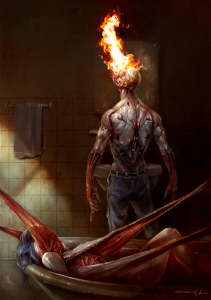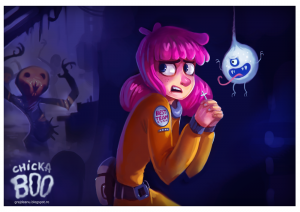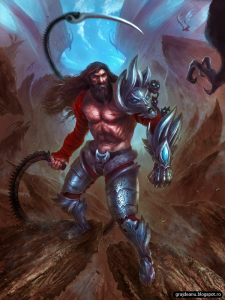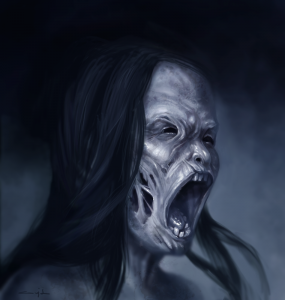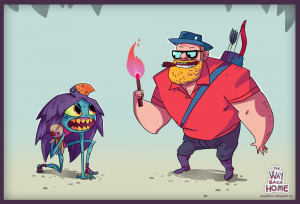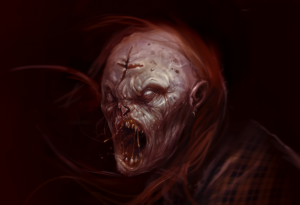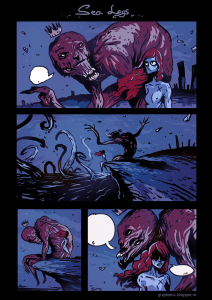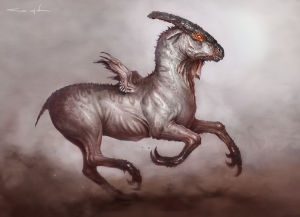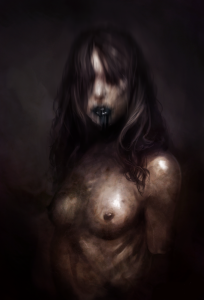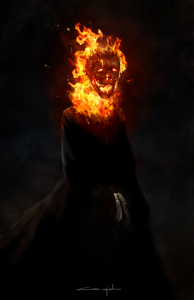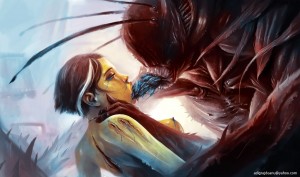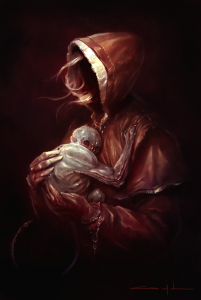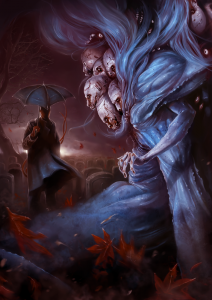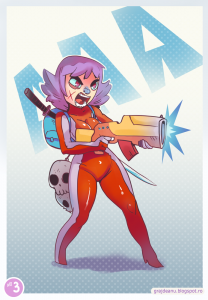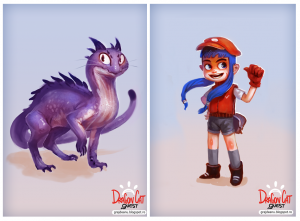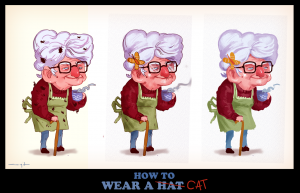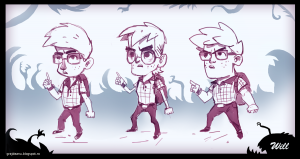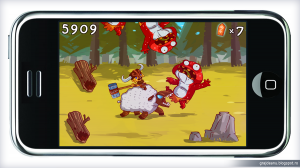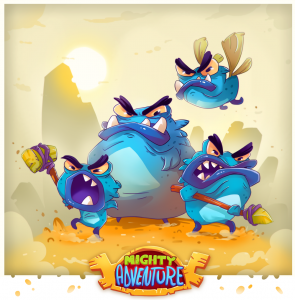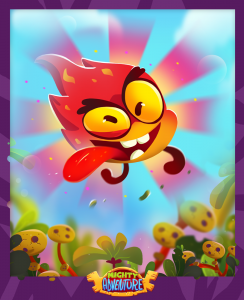Adrian Grajdeanu is an experienced graphic artist living in Bucharest, Romania. His style is very complex and he creates lively, strong characters, equally convincing – whether they are dark, intense horror types or colorful, funny cartoonish. And if the feeling you get when first encountering his characters is that they have a life of their own, outside of what you see on paper… then you might be right! Adrian’s intriguing extended range of design styles comes from many years of experimenting and developing his skills in every way he saw possible. In his career, when he wasn’t working for companies like EA (Electronic Arts), he worked as a freelancer and collaborator, doing from illustrations, character designs and game graphics, to comics, storyboards, book covers and TV commercials. Adrian is currently part of the team at Pixel Trap gaming studio, working on a mobile game soon to be released, called Mighty Adventure. When he isn’t working as an artist, he loves being a teacher and sharing his knowledge with anyone who wants to learn character design and illustration, through organized courses or just one-on-one talks.
What makes a character/person a monster is not defined by how it looks. What makes a monster is what that character does.
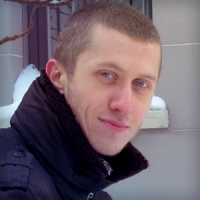 By looking at your portfolio, I notice you have quite an attraction to dark, quirky characters. Where does that come from?
By looking at your portfolio, I notice you have quite an attraction to dark, quirky characters. Where does that come from?
It’s hard to say because this has been with me since I was very little. That ‘dark’ world feels very familiar to me, it feels like a place I have always known. When I create those kind of characters, or even when I daydream of ‘dark’ stories, I feel comfortable and free. People always ask me how can I draw all those creatures and monsters. The thing is that to me they are not something repulsive, I don’t see them as been creepy or grotesque or as a mindless thing that only want to inflect pain. To me they are fascinating, beautiful, interesting, even normal and most of the time with a personal story behind them that gives them a ‘soul’. People judge too quickly by the looks or because of the preconceptions they have. What makes a character/person a monster is not defined by how it looks. What makes a monster is what that character does.
You have quite a large range of drawing styles, it’s amazing. Is that at all common in an artist, from your experience?
Finding a personal style is important to an artist. This makes you stand out from the ground and it gives you an identity. It can drive one insane as he or she is exploring, especially when they are just starting out.
As an artist it is natural to want to explore and experiment. For me this desire comes from a special place inside that always wants to be expressed. Life and the experiences I have make me see things in different ways, in different times. My feelings and perceptions change, and when this happens as an artist I gain new sources from which I can create.
Nowadays artists, and especially the new comers, are influenced by what is ‘cool’ or by what is in demand by the studios and they stick to that. They jump the personal exploration part. This limits their potential. When you explore different styles you gain new knowledge and understanding, plus in this industry it is good for you to be flexible, because projects will vary and you don’t what to miss out.
One of the best places you can learn is at home. You can get books from libraries and with the entire internet at the tips of your fingers everything is accessible
Have you studied art? Or are you self-taught?
I did go to art schools, but the teaching system there was outdated. It was almost impossible to learn something really useful in a place where the teachers showed very little interest in the students. A lot of times I got in fights with them because of this. The only thing that i do appreciate is how studying at a graphic design school has enhanced the way I do character designs.
One of the best places you can learn is at home, you can get books from libraries and with the entire internet at the tips of your fingers everything is accessible. That IS how I did it, I went to school just because, and at home I did research and drew whatever I wanted and found interesting.
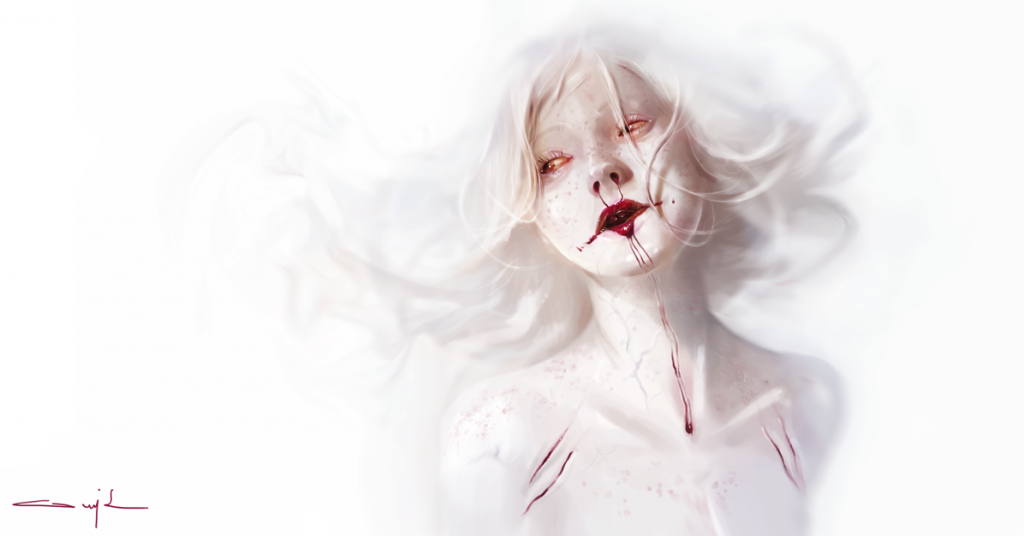
How many years of art experience do you have behind you?
Well… I have been drawing since I was little, but professionally I’ve been doing this for about 8 years.
Do you draw only digitally, or also on paper? What tools do you use?
The final pieces I do them digitally in Photoshop using an Intous4 tablet. Working digitally has many advantages because you can get faster results and the flexibility to change anything as you wish. But nothing compares with the feeling of pencil and pen on paper. It is fluid. Most of my ideas and sketches take place on papers, post notes or in notebooks.
Designing implies thinking, so that is why I consider that a visual designer should also have some psychology knowledge
You draw intense horror characters, but also cartoon characters for kids’ games. Do you find it at all difficult drawing in such different styles? It looks like it must be quite a step out of your comfort zone, how do you do it?
Switching between the two categories comes easy for me. I like them both and each of them allows me to communicate different sides of myself. When it comes to doing cartoons characters I find it a lot more challenging. A lot of people may think that doing toons is a piece of cake, but they miss a lot of the layers that are involved in building a good design. When doing toons you cannot hide behind tons of details, everything needs to be clear and communicate the right thing. Every element that it is used in the design is perceived in a particular way by the conscious or the unconscious of the viewer. By element I mean the color, shapes, lines, proportions, wardrobe, and the attitude of the character and so on. Each of these elements is associated with different things and have a different impact on the viewer.
Designing implies thinking, so that is why I consider that a visual designer should also have some psychology knowledge.
The greatest thing about doing cartoon characters is that It allows you to play a lot. It is one of the freest fields in characters designing.
In your spare time, draw the hell out of whatever interests you, keep your imagination alive
You create a lot of art for mobile games. In terms of drawing style, how would you say this kind of art is different from another?
There is no need to mold the style just because it is a mobile game. The drawing style can be whatever is in the art direction and especially decided by who is the user target.
If you had a piece of advice to give to someone aspiring to become a mobile game apps designer, what would it be?
When working on video games you usually concentrate only characters, or backgrounds, or the interface. In games for mobile you will probably end up doing all the graphics and is best to know how to do them all. Exploring all these categories ahead of time will definitely help ease the switching between them. Second to that, in your spare time draw the hell out of whatever interests you, keep your imagination alive.
What are the most important things they would need to do, in order to be able to design in that particular style?
To be able to design in a particular style, first you need to understand the rules of that style. Once you see what are the elements that make it the way it is, the rest comes easy. Practicing it will make it feel natural and you will feel comfortable. If there is room for it, put your own spin on it and even make into something that is yours. Most importantly enjoy it, because you are learning something new that will enhance your skills and knowledge.
You mentioned understanding the rules. What are the rules here, how do you figure them out?
In understanding styles, an easy way to put this is to just take a Disney character and compare it to an anime character. Side by side you clearly see the differences. Each of the two have a different drawing line, a specific way the shades are set, different anatomy, different level of detail and so on. Both of them have a different way of interpreting what we call as being real. These differences and interpretations are the elements of that compose a style.
First of all when working with a client the job is to hit a target. As a designer you have an expertise and the client needs to trust your decisions and suggestions. In the end, the client is the one who has the final word, it’s his project.
Before anything else, you are a character designer. How free are you when creating a character for a client (in terms of process and of how much you bring to the character, from your imagination)?
First of all when working with a client the job is to hit a target. Sometimes the starting point/the brief can be full with details and the client wants something very specific. On a different project the information I get is very little. Other times is somewhere in the middle. It depends, but in every of these cases there is a communication with the client as the design is shaping up.
The way I express that character is up to me, I pitch each idea and guide the client towards what I consider to be the right direction. As a designer you have an expertise and the client needs to trust your decisions and suggestions. In the end, the client is the one who has the final word, it’s his project. My job is to deliver the best design while making him happy.
So what would you advise a freelance artist who deals with a client brief on character design? What is the best way for them to make sure they set an efficient objective with the client, and get all the info they need, before starting to work on the design?
From the initial information you get from a client you will need to ask questions about the project and character, to outline as much as possible the idea of what he wants. Then there is a step by step process as you show the client your ideas and continue discussing on the design. This will go on until it all shapes up as the final work. Along the process the client may also not like your ideas, change his mind or he will even go with something that he initially didn’t like. The process is a combination of the designer’s input and the client’s.

What I do differently is that I treat the character as a real person or creature. I find out who that character is and what it does. I create a history for him and that gives me a strong base line upon which I build up.
Everyone usually has a process. Do you have some clear steps you follow when creating a character?
I sketch and research like everyone else. What I do differently is that I treat the character as a real person or creature. I find out who and what that character does. I create a history for him and that gives me a strong base line upon which I build up.
What usually inspires you? Where do you look for ideas, when you are stuck and you have a deadline?
I don’t get stuck that much anymore. I actually don’t remember the last time that happened. As time passed my thinking has developed in such a way that allows me to find solutions.
I find inspiration in everything and I am work on building my mental library as much as I can. The world is full of information, and I pay attention to that. I analyze what I see and try to understand how it is designed. I deconstruct piece by piece. How I connect the information I gather is what helps me shape the designs I do.
Exploring and understanding is the answer for new ideas.
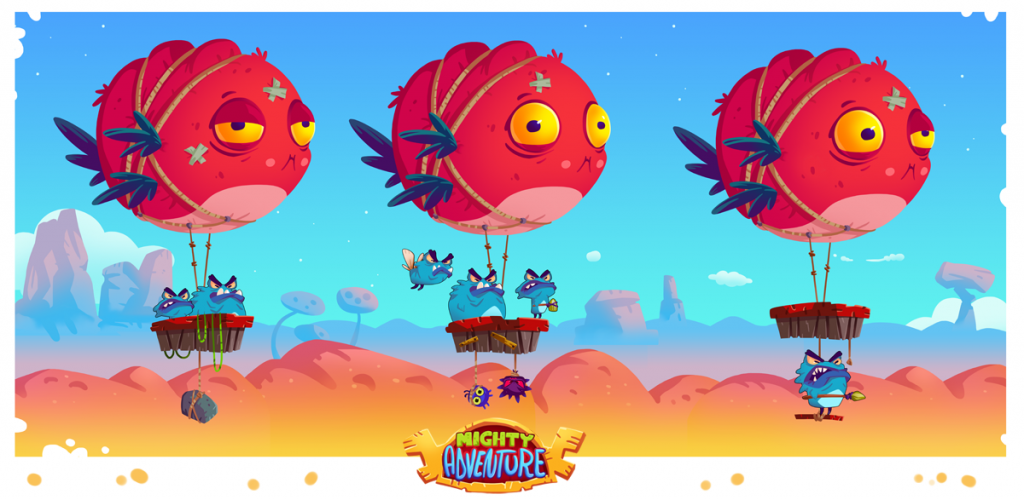
Our goal is to embark the player into a mighty adventure. We want to deliver something unique, fun, with awesome atmosphere and personality. We really want it to feel like a Mighty Adventure.
You are currently part of Pixel Trap, working on a new mobile game, Mighty Adventure. What is the story there?
Mighty Adventure is a story about three little creatures, kids who are part of a tribe with special running and jumping powers. Our little jumpers are a bunch of naughty ones, in training at the Jumper Temple. They have much to learn but decide to prove to their master that they are ready and they sneak out from the temple. Of course they are not ready, but as the adventure enfolds they learn the way of the jumpers – how to work as one .Their journey starts out innocent but as things turn out it becomes a Mighty Adventure, creating a legend from their awesome deeds.
What challenges did you find, while creating the concept & graphics for this game?
For this game I am doing all the 2d art, except the animation, and that involves a lot of decision making and designing, especially because I wanted the visuals to be as non-repetitive as possible. Each chapter has a different theme, and each part of a level tells a story. To have different stories told by the environment was a decision I made from the start, to make the world of the game feel real.
What makes Mighty Adventure different, in your opinion, from what is out there, now?
Just like the game’s name says, our goal is to embark the player into a mighty adventure. The game is a running game and usually this type is very repetitive as a gameplay and especially as art. We want to deliver something unique, fun, with awesome atmosphere and personality. We really want it to feel like a Mighty Adventure.
If you liked the images above, follow Adrian’s blog. As he works on a character, along with it he develops the story around it and he writes it all on his blog. He sometimes also documents the work process he went through, while creating the designs. See more of Adrian Grajdeanu’s amazing work on his: Blog | Behance | Facebook
